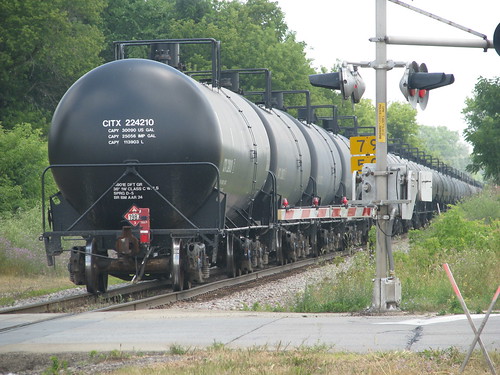
photo credit
In the past twelve months, ethanol exports from the United States have increased from 4 million gallons in March of '09 to 46 million gallons in March of this year to places like United Arab Emirates, Brazil, Canada, and the Netherlands. This year's March figure is about 4 percent of the 12 billion gallons mandated for domestic biofuel use this year. Ethanol producers are thrilled.
From the Grand Island Independent in Nebraska:
Exports fuel Nebraska's ethanol industry
The United States has gone from being a net importer of ethanol to a net exporter, which will continue to help fuel Nebraska's growing ethanol market, said Todd Sneller, executive administrator of the Nebraska Ethanol Board.
According to the Renewable Fuels Association (RFA), data from the U.S. Department of Agriculture, Department of Commerce and the Census Bureau indicate U.S. ethanol exports increased significantly in 2010.
In March, the U.S. exported more than 45 million gallons of ethanol. For the first quarter of 2010, U.S. exports exceeded 83 million gallons. By country, Canada and the Netherlands were the top importers of U.S. ethanol. U.S. ethanol is also finding its way into Brazil and OPEC nations in the Middle East.
According to the RFA analysis, one reason for America's surge as a global ethanol trader is its current advantage as the world's low-cost producer.
"Despite the Brazilian ethanol industry's recent attempts to portray its product as always being the cheapest in the world, current prices show Iowa ethanol plant-gate ethanol prices are 50 cents per gallon lower than Brazilian ethanol prices," RFA reported. "As recently as February, that spread exceeded $1 per gallon. By way of example, a gallon of ethanol containing 10 percent ethanol from the U.S. would cost 11 cents less than a similar gallon blended with 10 percent Brazilian product."
Another reason for the growth of U.S. ethanol exports, according to RFA, is the saturated domestic market for ethanol.
"Ethanol use in the U.S. is arbitrarily capped at 10 percent per gallon of gasoline (E10). Based on historic gasoline demand trends, this arbitrary 10 percent cap, called the 'Blend Wall,' would be around 12.5-13.5 billion gallons of ethanol. The U.S. industry has the capacity to produce 13.5 billion gallons annually, with more capacity waiting in the wings," RFA reported. to continue reading. . .
According to the Renewable Fuels Association (RFA), data from the U.S. Department of Agriculture, Department of Commerce and the Census Bureau indicate U.S. ethanol exports increased significantly in 2010.
In March, the U.S. exported more than 45 million gallons of ethanol. For the first quarter of 2010, U.S. exports exceeded 83 million gallons. By country, Canada and the Netherlands were the top importers of U.S. ethanol. U.S. ethanol is also finding its way into Brazil and OPEC nations in the Middle East.
According to the RFA analysis, one reason for America's surge as a global ethanol trader is its current advantage as the world's low-cost producer.
"Despite the Brazilian ethanol industry's recent attempts to portray its product as always being the cheapest in the world, current prices show Iowa ethanol plant-gate ethanol prices are 50 cents per gallon lower than Brazilian ethanol prices," RFA reported. "As recently as February, that spread exceeded $1 per gallon. By way of example, a gallon of ethanol containing 10 percent ethanol from the U.S. would cost 11 cents less than a similar gallon blended with 10 percent Brazilian product."
Another reason for the growth of U.S. ethanol exports, according to RFA, is the saturated domestic market for ethanol.
"Ethanol use in the U.S. is arbitrarily capped at 10 percent per gallon of gasoline (E10). Based on historic gasoline demand trends, this arbitrary 10 percent cap, called the 'Blend Wall,' would be around 12.5-13.5 billion gallons of ethanol. The U.S. industry has the capacity to produce 13.5 billion gallons annually, with more capacity waiting in the wings," RFA reported. to continue reading. . .
There is nothing low cost about exploiting our land to produce politically driven, taxpayer subsidized ethanol through industrialized corn growing. One third of our corn crop now goes towards ethanol production and the corn growers and ethanol interests would like to see mandates for yet higher blends. How can they refer to this product as low-cost when its survival isn't even feasible without the taxpayer subsidies? Corn ethanol's already low EROEI becomes even lower after shipment overseas.
And, another important point:
In Nebraska, completion of two ethanol production facilities in Aurora and Columbus will increase the state's ethanol production capacity to 2.2 billion gallons, providing a market for more than 700 million bushels of corn. Last year, Nebraska's corn crop totaled 1.58 billion bushels. This year, Nebraska farmers planted 9.2 million acres of corn, up 1 percent from 2009.
According to Sneller, Nebraska uses about 50 million gallons of ethanol within the state, with the rest exported for use outside Nebraska.
According to Sneller, Nebraska uses about 50 million gallons of ethanol within the state, with the rest exported for use outside Nebraska.
Nebraska's extremely productive corn output is dependent upon irrigation, which is depleting the Ogallala aquifer and requires even more electrical energy to produce, thus an even lower EROEI than corn from other states. A better ethanol policy would, at minimum, exclude irrigated corn from eligibility of taxpayer subsidies. Instead, current policy is increasing irrigation demand. Nebraska's two new plants are in the midst of irrigation country.
While the rest of the world laments the BP Oil spill disaster (don't get me wrong, I do, too) most American's today are oblivious to the fact that 98% of the Great Plains ecosystems have been decimated by industrial agriculture. Exporting corn ethanol is nothing short of agribusiness insanity.